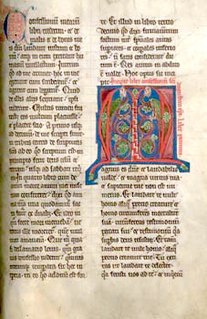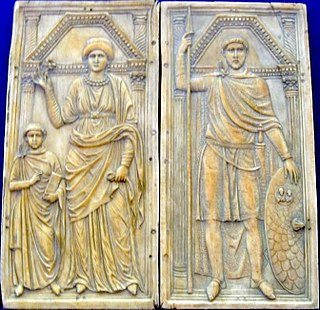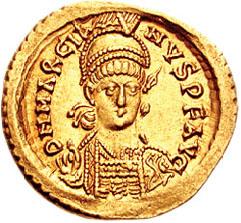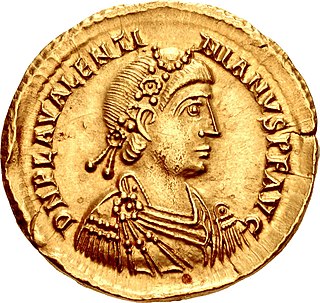 W
WThe Theodosian dynasty was a Roman imperial family that produced five Roman emperors during Late Antiquity, reigning over the Roman Empire from 379 to 457. The dynasty's patriarch was Theodosius the Elder, whose son Theodosius the Great was made Roman emperor in 379. Theodosius's two sons both became emperors, while his daughter married Constantius III, producing a daughter that became an empress and a son also became emperor. The dynasty of Theodosius married into, and reigned concurrently with, the ruling Valentinianic dynasty, and was succeeded by the Leonid dynasty with the accession of Leo the Great.
 W
WProcopius Anthemius was western Roman emperor from 467 to 472.
 W
WFlavius Arcadius was Roman emperor from 383 to 408. He was the eldest son of the augustus Theodosius I and his first wife Aelia Flaccilla, and the brother of Honorius. Arcadius ruled the eastern half of the empire from 395, when their father died, while Honorius ruled the west. A weak ruler, his reign was dominated by a series of powerful ministers and by his wife, Aelia Eudoxia.
 W
WThis history of the Byzantine Empire covers the history of the Eastern Roman Empire from late antiquity until the Fall of Constantinople in 1453 AD. Several events from the 4th to 6th centuries mark the transitional period during which the Roman Empire's east and west divided. In 285, the emperor Diocletian partitioned the Roman Empire's administration into eastern and western halves. Between 324 and 330, Constantine I transferred the main capital from Rome to Byzantium, later known as Constantinople and Nova Roma. Under Theodosius I, Christianity became the Empire's official state religion and others such as Roman polytheism were proscribed. And finally, under the reign of Heraclius, the Empire's military and administration were restructured and adopted Greek for official use instead of Latin. Thus, although it continued the Roman state and maintained Roman state traditions, modern historians distinguish Byzantium from ancient Rome insofar as it was oriented towards Greek rather than Latin culture, and characterised by Orthodox Christianity rather than Roman polytheism.
 W
WThe Council of Chalcedon was a church council held from 8 October to 1 November, 451, at Chalcedon, a town of Bithynia in Asia Minor. The Council was called by Emperor Marcian to set aside the 449 Second Council of Ephesus. Its principal purpose was to assert the orthodox catholic doctrine against the heresy of Monophysitism and Eutyches, although ecclesiastical discipline and jurisdiction also occupied the council's attention.
 W
WThe Battle of the Catalaunian Plains, also called the Battle of the Campus Mauriacus, Battle of Châlons, Battle of Troyes or the Battle of Maurica, took place on June 20, 451 AD, between a coalition led by the Roman general Flavius Aetius and the Visigothic king Theodoric I against the Huns and their vassals commanded by their king Attila. It was one of the last major military operations of the Western Roman Empire, although Germanic foederati composed the majority of the coalition army. Whether the battle was strategically conclusive is disputed: the Romans possibly stopped the Huns' attempt to establish vassals in Roman Gaul. However, the Huns successfully looted and pillaged much of Gaul and crippled the military capacity of the Romans and Visigoths. Attila died only two years later and his Hunnic Empire was dismantled by a coalition of their Germanic vassals after the Battle of Nedao in 454.
 W
WOn the city of God against the pagans, often called The City of God, is a book of Christian philosophy written in Latin by Augustine of Hippo in the early 5th century AD. The book was in response to allegations that Christianity brought about the decline of Rome and is considered one of Augustine's most important works, standing alongside The Confessions, The Enchiridion, On Christian Doctrine, and On the Trinity. As a work of one of the most influential Church Fathers, The City of God is a cornerstone of Western thought, expounding on many profound questions of theology, such as the suffering of the righteous, the existence of evil, the conflict between free will and divine omniscience, and the doctrine of original sin.
 W
WThe Codex Theodosianus was a compilation of the laws of the Roman Empire under the Christian emperors since 312. A commission was established by Emperor Theodosius II and his co-emperor Valentinian III on 26 March 429 and the compilation was published by a constitution of 15 February 438. It went into force in the eastern and western parts of the empire on 1 January 439. The original text of the codex is also found in the Breviary of Alaric, promulgated on 2 February 506.
 W
WConfessions is an autobiographical work by Saint Augustine of Hippo, consisting of 13 books written in Latin between AD 397 and 400. The work outlines Saint Augustine's sinful youth and his conversion to Christianity. Modern English translations of it are sometimes published under the title The Confessions of Saint Augustine in order to distinguish the book from other books with similar titles. Its original title was Confessions in Thirteen Books, and it was composed to be read out loud with each book being a complete unit.
 W
WConstantius III was Roman emperor of the West in 421, from 8 February until his death on 2 September. He earned his position as Emperor due to his capability as a general under Honorius, achieving the rank of Magister militum by 411. That same year, he was sent to suppress the revolt of Constantine III, a Roman general who declared himself emperor. Constantius led his army to Arles in Gaul, the capital of Constantine III, and defeated Gerontius, a general rebelling against Constantine, before himself besieging Arles. After defeating a relief force led by Edobichus, Constantius convinced Constantine to surrender, promising safe retirement, but betrayed and beheaded him as soon as he surrendered. Constantius then went on to lead campaigns against various barbarian groups in Hispania and Gaul, recovering much of both for the Western Roman Empire. Constantius was proclaimed Western Roman Emperor by Honorius on 8 February 421. He reigned for seven months before dying on 2 September 421.
 W
WThe Council of Ephesus was a council of Christian bishops convened in Ephesus in AD 431 by the Roman Emperor Theodosius II. This third ecumenical council, an effort to attain consensus in the church through an assembly representing all of Christendom, confirmed the original Nicene Creed, and condemned the teachings of Nestorius, Patriarch of Constantinople, who held that the Virgin Mary may be called the Christotokos, "Birth Giver of Christ" but not the Theotokos, "Birth Giver of God". It met in June and July 431 at the Church of Mary in Ephesus in Anatolia.
Eagle in the Snow (ISBN 1-59071-011-8) is a 1970 historical fiction novel, written by Wallace Breem, which revolves around the Roman general Paulinus Gaius Maximus, a Mithraic in an age of Christianization, in Britannia and Germania, between the late 4th century and the early 5th century.
 W
WEucherius was the son of Stilicho, the magister militum of the Western Roman Empire, and Serena, a Roman noblewoman who was the niece of Eastern Roman Emperor Theodosius I. He was born in c. 388 in Rome, Italy. Despite being the son of the magister militum, Eucherius did not rise farther than the modest rank of Tribune of the Notaries. Stilicho was accused by his political opponents of plotting to install Eucherius as a third emperor in Illyricum, and as a result of this both Stilicho and Eucherius were arrested and executed, on 22 August 408.
 W
WAelia Eudocia Augusta, also called Saint Eudocia, was a Greek Eastern Roman Empress by marriage to Byzantine emperor Theodosius II.
 W
WAelia Eudoxia was a Roman Empress consort by marriage to the Roman Emperor Arcadius. The marriage was the source of some controversy, as it was arranged by Eutropius, one of the eunuch court officials, who was attempting to expand his influence, and whom she later had executed. As Empress, she came into conflict with John Chrysostom, the Patriarch of Constantinople, who was popular among the common folk for his denunciations of imperial and clerical excess. She had five children, four of whom survived to adulthood, including her only son and future emperor Theodosius II, but she had two additional pregnancies that ended in either miscarriages or stillbirths and she died as a result of the latter one.
 W
WLicinia Eudoxia was a Roman Empress, daughter of Eastern Roman Emperor Theodosius II. Her husbands included the Western Roman Emperors Valentinian III and Petronius Maximus.
 W
WThe First Council of Constantinople was a council of Christian bishops convened in Constantinople in AD 381 by the Roman Emperor Theodosius I. This second ecumenical council, an effort to attain consensus in the church through an assembly representing all of Christendom, except for the Western Church, confirmed the Nicene Creed, expanding the doctrine thereof to produce the Niceno-Constantinopolitan Creed, and dealt with sundry other matters. It met from May to July 381 in the Church of Hagia Irene and was affirmed as ecumenical in 451 at the Council of Chalcedon.
 W
WAelia Flavia Flaccilla, was a Roman empress and first wife of the Roman Emperor Theodosius I. She was of Hispanian Roman descent. During her marriage to Theodosius, she gave birth to two sons – future Emperors Arcadius and Honorius – and a daughter, Aelia Pulcheria. She was titled Augusta, as her coinage shows.
 W
WJusta Grata Honoria, commonly referred to during her lifetime as Honoria, was the older sister of the Western Roman Emperor Valentinian III. She is famous for her plea of love and help to Attila the Hun, which led to his proclamation of his claim to rule the Western Roman Empire.
 W
WFlavius Honorius was Roman emperor from 393 to 423. He was the younger son of emperor Theodosius I and his first wife Aelia Flaccilla, and brother of Arcadius, who ruled the eastern half of the empire from 395, when their father died, until his death in 408. In 410, during Honorius's reign over the western Roman Empire, Rome was sacked for the first time in almost 800 years.
 W
WAnicia Juliana was a Late Antique Roman imperial princess, wife of the magister militum of the eastern Roman empire, Areobindus Dagalaiphus Areobindus, patron of the great Church of St Polyeuctus in Constantinople, and owner of the Vienna Dioscurides. She was the daughter of the Roman emperor Olybrius and his wife Placidia, herself the daughter of the emperor Valentinian III and Licinia Eudoxia, through whom Anicia Juliana was also great-granddaughter of the emperor Theodosius II and the sainted empress Aelia Eudocia. During the rule of the Leonid dynasty and the rise of the later Justinian dynasty, Anicia Juliana was thus the most prominent member of both the preceding imperial dynasties, the Valentinianic dynasty established by Valentinian the Great and the related Theodosian dynasty established by Theodosius the Great.
 W
WMarcian was Roman emperor of the East from 450 to 457. Very little of his life before becoming emperor is known, other than that he was a domesticus who served under the commanders Ardabur and his son Aspar for fifteen years. After the death of Emperor Theodosius II on 28 July 450, Marcian was made a candidate for the throne by Aspar, who held much influence because of his military power. After a month of negotiations Pulcheria, Theodosius' sister, agreed to marry Marcian. Flavius Zeno, a military leader whose influence was similar to Aspar's, may have been involved in these negotiations, as he was given the high-ranking court title of patrician upon Marcian's accession. Marcian was elected and inaugurated on 25 August 450.
 W
WMaria was the first Empress consort of Honorius, Western Roman Emperor.
 W
WThe Battle of the Nervasos Mountains occurred in the year 419 and was fought between a coalition of Suebi, led by King Hermeric together with allied Roman Imperial forces stationed in the Province of Hispania, against the combined forces of the Vandals and Alans who were led by their King Gunderic. This battle occurred in the context of a contemporary Germanic invasion of the Iberian Peninsula. The battle took place in what is today the Province of León, Spain, and resulted in a Roman/Suebian Victory.
 W
WAnicius Olybrius was Roman emperor from April or May 472 until his death later that same year; his rule as augustus in the western Roman Empire was not recognised as legitimate by the ruling augustus in the eastern Roman Empire, Leo I. He was in reality a puppet ruler raised to power by Ricimer, the magister militum of Germanic descent, and was mainly interested in religion, while the actual power was held by Ricimer and his nephew Gundobad.
 W
WThe Battle of Orléans took place in the year 463 pitting the forces of the Kingdom of Soissons, under the command of the magister militum Aegidius, against those of the Visigoths who were commanded by the Visigoth King Theodoric II and his brother Federico.
 W
WPetronius Maximus was Roman emperor of the West for two and a half months in 455. A wealthy senator and a prominent aristocrat, he was instrumental in the murders of the Western Roman magister militum, Aëtius, and the Western Roman emperor, Valentinian III.
 W
WPlacidia was a daughter of Valentinian III, Roman emperor of the West from 425 to 455, and from 454/455 the wife of Olybrius, who became western Roman emperor in 472. She was one of the last imperial spouses in the Roman west, during the Fall of the Western Roman Empire during Late Antiquity.
 W
WGalla Placidia, daughter of the Roman emperor Theodosius I, was regent to Valentinian III from 423 until his majority in 437, and a major force in Roman politics for most of her life. She was queen consort to Ataulf, king of the Visigoths from 414 until his death in 415, and briefly empress consort to Constantius III in 421.
 W
WAelia Pulcheria was regent of the Eastern Roman Empire during the minority of her brother Theodosius II and then empress in her own right from July 450 to her death in 453, together with her husband Marcian from November 450.
 W
WFlavius Ricimer was a Romanized Germanic general who effectively ruled the remaining territory of the Western Roman Empire from 461 until his death in 472, with a brief interlude in which he contested power with Anthemius. Deriving his power from his position as magister militum of the Western Empire, Ricimer exercised political control through a series of puppet emperors.
 W
WSerena was a Christian noblewoman of the late Western Roman Empire.
 W
WFlavius Stilicho was a high-ranking general in the Roman army who, for a time, became the most powerful man in the Western Roman Empire. He was half Vandal and married to the niece of Emperor Theodosius I; his regency for the underage Honorius marked the high point of Germanic advancement in the service of Rome. After many years of victories against a number of enemies, both barbarian and Roman, a series of political and military disasters finally allowed his enemies in the court of Honorius to remove him from power, culminating in his arrest and subsequent execution in 408. Known for his military successes and sense of duty, Stilicho was, in the words of historian Edward Gibbon, "the last of the Roman generals."
 W
WTheodosius I, also called Theodosius the Great, was Roman emperor from 379 to 395, during Late Antiquity. His reign accelerated the Christianization of the Roman Empire, achieved military successes when the frontiers of the empire were threatened by the wars of the Migration Period, and defeated two rival emperors in successive civil wars. He was the first emperor of the Theodosian dynasty, and married into the ruling Valentinianic dynasty. His decrees made Nicene Christianity the state church of the Roman Empire and punished Roman paganism, Hellenistic religion, and Arianism. At his capital Constantinople he commissioned the honorific Column of Theodosius, the Theodosian Walls, and the Golden Gate, among the greatest works of ancient Roman architecture.
 W
WTheodosius II, commonly called Theodosius the Younger or the Calligrapher, was Roman emperor for most of his life, proclaimed augustus as an infant in 402 and ruling as the eastern Empire's sole emperor after the death of his father Arcadius in 408. His reign was marked by the promulgation of the Theodosian law code and the construction of the Theodosian Walls of Constantinople. He also presided over the outbreak of two great Christological controversies, Nestorianism and Eutychianism.
 W
WValentinian III was Roman emperor of the West from 425 to 455. His reign was marked by the ongoing collapse of the Western Empire.